In preparing our January-February cover story, we at Healthcare Innovation surveyed nearly 200 senior executives who are leading hospitals, medical groups, health systems, other provider organizations, health information exchanges (HIEs), and health plans, to obtain the pulse of change, as the U.S. healthcare industry shifts from a volume-based payment and delivery system to a value-based one. As noted in our cover story, we found a range of survey results in key areas around strategic development, population health management and care management, and cybersecurity, among other subject areas. Overall, we found mixed progress forward in the current operational landscape.
We received responses across a large number of topical areas, and found that we couldn’t include all responses in our cover story. Below are some of additional survey results, across a broad range of topics. They show a very broad range of preparation for future trends, developments, and challenges.
We asked respondents, “Are you actively working on incorporating social determinants of health (SDOH) data into your population health and care management work?” And while 45.3 percent said yes, and 41.3 percent said not yet, but that they are planning to do so, 10 percent said they had no plans to do so.
We asked respondents whether their organizations were involved in the development of patient-centered medical homes. More than one-third—37.3 percent said yes; an additional 21.3 percent said not yet, but that they were planning to do so; but fully 41.3 percent said they had no plans to do so.
What about participation in the federal Comprehensive Primary care Plus (CPC+) Program? In that case, just 13.3 percent are currently involved in the CPC+ Program, while an additional 26.67 percent are planning to participate; but fully 60 percent have no plans to do so.
What about the development of an integrated oncology care model? Twenty percent are already involved in developing such models, and an additional 24 percent said they planned to do so; but fully 56 percent had no plans to do so.
Infrastructure and other issues revealed
What about some significant infrastructure issues? We found that only 45.3 percent of respondents reported that their organizations currently have an enterprise-wide data warehouse in place, though an additional 21.3 percent are planning to do so. Perhaps surprisingly, fully 33.3 percent have no plans to do so.
What about the use of artificial intelligence and machine learning tools for clinical transformation work? Right now, only 17.3 percent of respondents say that their organizations are actively already using such tools in their clinical transformation work, but fully 38.67 are planning to do so. Still, 44 percent report that they have no plans to do so. Very similar results came about when asking respondents about their use of AI and machine learning tools for operational work: 17.3 percent are doing so now, 40 percent plan to do so, and 42.67 have no such plans.
What about participation in health information exchanges (HIEs)? The majority of organizations (53.3 percent) are doing so; and another 29.3 percent plan to participate in an HIE. Only 17.3 percent have no such plans. And, asked whether they are participating in a statewide HIE, fully 44 percent are doing so now, while an additional 30.67 percent have plans to do so. Only one-quarter (25.3 percent) have no such plans.
What about sharing data with skilled nursing facilities and long-term care facilities? Thirty-six percent are doing so no; 28 percent plan to do so; 36 percent have no plans to do so.
What about OpenNotes? We found that 22.67 percent of organizations have implemented OpenNotes and given patients direct access to their physicians’ notes; another 29.3 percent are planning to do so; but fully 48 percent have no plans to do so.
Perhaps even more surprising was the result around chief medical information officers (CMIOs): while 40 percent of the organizations polled have a CMIO in place, fully 60 percent do not. Meanwhile, 25 percent of organizations have a CMIO who reports to the CEO, 12 percent have a CMIO who reports to the CIO, 4 percent have a CMIO who reports to the COO, and 6.67 percent have a CMIO who reports to some other title. What’s more, only 10.67 have a chief nursing information officer (CNIO), while 89.3 percent do not.
What is the top strategic IT priority for their organization in the next three years? Here were the results: the largest number—38.67 percent—said data analytics optimization; and the second-largest number—26.67 percent—said EHR (electronic health record) optimization. Meanwhile, 17.3 percent said infrastructure and platform development; 14.67 percent said revenue cycle management optimization; and 2.67 specified a range of other foci.
Perhaps not surprisingly, only a small percentage of organizations are currently involved in genomic medicine development: 14.67 percent. A further 24 percent plan to get involved; but 61.3 percent have no plans to do so.
Do organizations have a formal IT project management office? 42.7 percent do, but 57.3 percent do not. What about the development of formal governance processes and policies? Seventy-two percent have developed such processes and policies, while only 28 percent have not.


